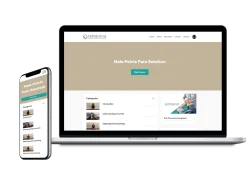After childbirth—especially a vaginal delivery—many women experience a strange, heavy feeling in their pelvic region. Some describe it as if “their vagina is about to fall out,” or they feel constant vaginal fatigue, pressure, or even pain. It’s easy to assume that these symptoms must be related to a prolapse, especially if you’ve been told you have one. However, heaviness after delivery is not always caused by a prolapse, even if one has been diagnosed. In fact, there are other, often overlooked causes that could be responsible.
Let’s explore what might really be going on, why you’re feeling that vaginal heaviness, and what you can do to get better.
The Common Scenario: “Why Am I Still Feeling Like This?”
You’re six weeks postpartum and expected to start feeling more like yourself. But instead, your body feels weak, your pelvic area aches or feels heavy, and you can’t imagine returning to work—especially if your job requires standing all day.
This exact concern was recently shared by a postpartum woman in a consult. She described feeling like her vagina was open, fatigued, and unsupported. Although she had a mild prolapse diagnosis, her symptoms didn’t match the severity of that prolapse. If this sounds like your experience, you’re not alone—and the issue may be something else entirely.
Why a Mild Prolapse Likely Isn’t the Culprit
This patient saw several professionals: a pelvic floor therapist, her OB-GYN, and a urogynecologist. The prolapse they found was mild—perhaps a grade one or two. But despite this, she was experiencing intense vaginal fatigue and heaviness.
Clinically, a grade two prolapse or lower usually doesn’t cause such severe symptoms—especially not that overwhelming “falling out” sensation. Even when standing or moving throughout the day, many women with mild prolapse don’t feel this level of discomfort.
So if not prolapse, what’s causing this heaviness?
The Unexpected Culprit: Pelvic Floor Muscle Strain or Spasm
While it’s tempting to assume that postpartum heaviness is due to weakness alone, muscle tightness or strain can actually mimic prolapse symptoms. Yes, even though your body has just gone through extreme stretching during delivery, certain pelvic floor muscles can become tight, overworked, or strained.
There are 14 different muscles that make up the pelvic floor, supporting the bladder, vagina, rectum, and uterus. These muscles form a kind of hammock across the bottom of your pelvis. During childbirth, they undergo immense stress, especially if there were tears or interventions like forceps or vacuum extraction.
In many cases, the sensation of heaviness is not due to the organs themselves shifting, but rather due to tension, inflammation, or spasm in some of these pelvic muscles. Tight muscles can put pressure on nearby nerves or create a pulling sensation, which your brain interprets as “something’s falling out.”
Why Early Internal Exams Can Worsen Symptoms
In the case discussed, the patient underwent an internal pelvic floor exam just two weeks postpartum. At that stage, the tissues are still healing, and any internal manipulation—no matter how gentle—can trigger inflammation, pain, or muscle guarding.
Most experienced pelvic floor therapists recommend avoiding internal exams until after six weeks postpartum, and even then, only if the patient is comfortable and not experiencing high levels of pain.
If you’re feeling worse after an early exam, that might be why. The exam likely didn’t cause your problem, but it may have stirred up already strained or irritated muscles, aggravating your symptoms.

Weakness vs. Tightness: The Key to Proper Recovery
A major takeaway from this case—and many like it—is that you can’t treat all postpartum pelvic symptoms the same way. The cause could be:
- True muscle weakness, requiring strengthening
- Tightness or spasm, requiring release and relaxation
- A combination of both
This distinction is critical. For example, doing Kegel exercises (pelvic floor contractions) can help in cases of weakness. But if your muscles are actually tight or spasming, Kegels can make things worse. Instead, you might need stretches, breath work, or manual therapy techniques.
That’s why thorough evaluation is essential. A pelvic floor specialist should ask detailed questions about your symptoms, daily habits, and how those symptoms change throughout the day. They might also assess your posture, abdominal pressure, and even how you breathe—all of which can affect your pelvic health.
What You Can Do to Ease the Heaviness
If you’re dealing with postpartum heaviness that doesn’t seem to align with your prolapse diagnosis, here are some key steps to take:
1. Pause and Rest
Give your body the grace to heal. Rest as much as possible and avoid standing for long periods. Use supportive pillows or wedges when sitting to reduce pelvic pressure.
2. Avoid High-Impact Activity
Now isn’t the time for high-intensity workouts or running. These can worsen symptoms. Focus on gentle movements and avoid any exercise that increases pelvic pressure.
3. Use Positioning to Your Advantage
Lying down, especially with your hips slightly elevated, can help relieve the sensation of heaviness by allowing your organs to shift away from the vaginal opening.
4. See a Pelvic Floor Therapist
Look for a therapist who specializes in postpartum care. They can evaluate your pelvic muscles, teach you proper exercises (or relaxation techniques), and guide your recovery journey.
5. Focus on Breathing and Core Engagement
Learning how to breathe properly—especially diaphragmatic breathing—can reduce internal pressure and support your core and pelvic floor. Core retraining is essential, but it has to be approached gently and intentionally.
6. Hydration and Nutrition
Tissue healing requires hydration and good nutrition. Dehydration can lead to muscle cramps and fatigue, worsening that heavy sensation.
When to Resume Strengthening Exercises
Once you and your therapist have confirmed that your symptoms are not due to tightness or spasm, you can begin rebuilding strength. Start slow. You may begin with:
- Gentle core activations (not crunches)
- Modified Kegels (if appropriate)
- Pelvic tilts
- Low-impact glute and hip strengthening
The goal is to gradually take pressure off the pelvic floor while improving overall support. With time, this can reduce that heavy, dragging feeling—even if you do have a mild prolapse.
You’re Not Doomed: Recovery Is Possible
If you’re feeling hopeless, confused, or even scared, know this: you will get better. Many women experience these same symptoms after birth, and with the right guidance, the heaviness and fatigue do go away.
The key is to treat your symptoms, not just the label of “prolapse.” Get a proper evaluation, follow a personalized recovery plan, and give yourself time.
Why You Feel Heaviness After Delivery – Final Thoughts
Postpartum heaviness is often misunderstood, misdiagnosed, or improperly treated. If you’ve been told you have a prolapse but your symptoms feel disproportionate—or don’t align with what your provider says—don’t panic.
It might not be the prolapse causing your symptoms at all. Muscle strain, tension, and postpartum healing complications are often the real source. And the good news? These are treatable.
With expert guidance, rest, and a tailored plan, you can return to feeling strong, supported, and symptom-free—whether that means chasing toddlers or returning to full-time work on your feet.
Also Read: Why Your SI Joint Pain Keeps Returning — And How to Fix It
I’m Hina Sheth. I have been treating complex orthopedics, sports and pelvic floor physical problems for over 25 years with amazing results. Now I want to bring my knowledge to the global community so I can spread my knowledge to you.
Our bodies are complex systems of 600 muscles and organs intertwined in a fascial system that all work together. Imbalances in this system such as trigger points, visceral and myofascial restrictions can lead to joint, pelvic, and organ issues.
Factors like nutrition, exercise, sleep, and stress play a crucial role. Unfortunately, our current healthcare model does not look at our bodies as a whole and oftentimes compartmentalize musculoskeletal injuries and dysfunctions.
At Rebalance, our goal is to holistically treat this complex system to restore harmony in the body. By addressing these imbalances, we help clients improve their overall health and well-being. Our vision is to empower individuals to create a healthier lifestyle for themselves.






